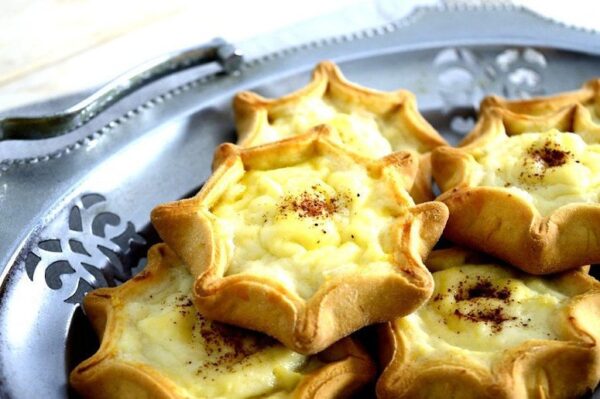Lichnarakia
Among the treasures of Cretan gastronomy, Kalitsounia stand out as one of the island’s most famous and beloved sweets — and the Easter sweet par excellence. Traditionally prepared to celebrate the Resurrection, these delicate pastries have long symbolised joy, hospitality, and abundance. Today, however, Kalitsounia grace Cretan tables not only at Easter but on any festive occasion throughout the year.
A Tradition with Many Faces
What makes Kalitsounia especially fascinating is its regional diversity. Every corner of Crete has its own take on these little pies, and each family guards its recipe as a culinary heirloom. Though they share a common heritage, the variations in filling, dough, and shape reflect the island’s rich agricultural landscape and deep respect for local ingredients.
Anevata
Sweet Kalitsounia: Lychnarakia and Anevata
The sweet versions of Kalitsounia are made with sweet mizithra cheese, a soft, fresh cheese that gives them their signature creamy texture. They come in two principal types:
-
Lychnarakia, named after the Greek word for “little lamps,” are open-faced pastries with crimped edges, often flavoured with cinnamon, vanilla, or orange zest, and drizzled with honey after baking. Their golden colour and shape symbolise light and celebration.
-
Anevata, whose name means “rising,” are made with yeasted dough that requires patience to swell before baking. This slow rising gives them a soft, airy texture and a rich, aromatic flavour. Anevata Kalitsounia are often prepared in advance of Easter, filling homes with the scent of baking and tradition.
(Close-up of sweet Greek ‘kalitsounia’ like small cheese pies baked in the oven — Anevata)
Savoury Kalitsounia: The Taste of the Cretan Hills
In western Crete, especially in the Chania region, savoury Kalitsounia reign supreme. These are filled with horta — wild greens and herbs gathered from the mountains — and are either baked in the oven or fried in olive oil. Another beloved version features fresh Cretan cheeses, such as salty xinomizithra, anthotyro, or tiromalama (a rich sheep-and-goat’s milk cheese), often flavoured with fresh mint. For a touch of contrast, they can be served with a few drops of honey or sprinkled with cinnamon, balancing salty and sweet in true Cretan fashion.
The Art of the Dough
The dough for Kalitsounia is simple but requires care. It’s traditionally made with flour, Cretan olive oil, raki or vinegar for crispness, and warm water or milk. For sweet versions, a little sugar and sometimes eggs are added. Rolling, filling, and shaping each piece by hand is a labour of love, often shared among family members during festive preparations.
Preserving a Sweet Tradition
Kalitsounia can be stored in the refrigerator or freezer in a tightly sealed container, making them easy to prepare in advance for celebrations. They reheat beautifully, maintaining their delicate flavour and texture — a practical touch that has helped this age-old pastry endure in modern kitchens.
A Symbol of Cretan Warmth
Whether sweet or savoury, baked or fried, Kalitsounia embody the spirit of Crete: simplicity elevated by skill, and tradition preserved through generations. Each bite tells a story — of family, festivity, and the enduring love between the Cretan people and their land.
In every household where they are made, Kalitsounia are more than just pastries. They are a symbol of light, joy, and the timeless art of sharing.
Photos: 2.bp.blogspot.com / paxxi.gr





